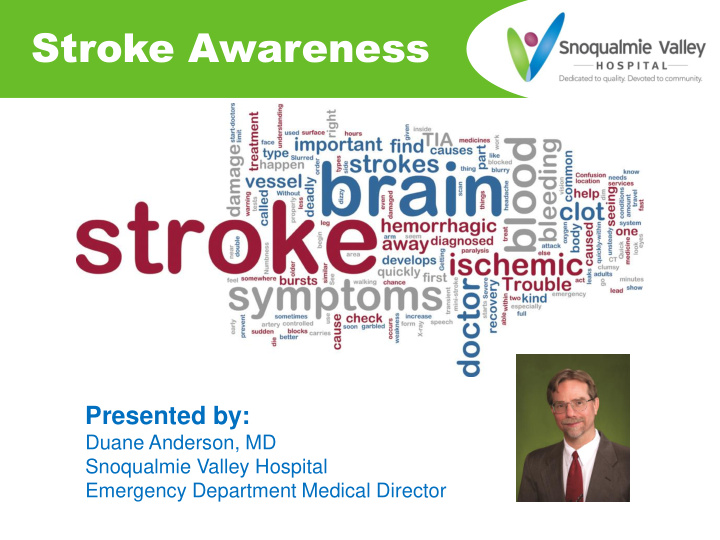



Stroke Awareness Presented by: Duane Anderson, MD Snoqualmie Valley Hospital Emergency Department Medical Director
What is a stroke? Stroke can happen to anyone. Stroke is the fourth leading cause of death among Americans, and about 800,000 people in the U.S. have a stroke each year, according to the Centers for Disease Control and Prevention.
Posterior Brain Circulation • Vertebral • Anterior Spinal • Posterior Spinal • Posterior Inferior Cerebellar • Basilar • Anterior Inferior Cerebellar • Superior Cerebellar • Posterior Cerebral
Hemorrhagic and Ischemic Stroke
Hemorrhagic Stroke Some strokes are due to a rupture of a blood vessel in the brain’s circulation, this is hemorrhagic.
Ischemic Stroke Most strokes are from a narrowing of arteries that give the brain less or no blood flow thus having brain cell damage or death. This is ischemic stroke.
Stroke Symptoms
Spot a Stroke: Act FAST F ACE: Ask the person to smile. Is one side drooping? Do they have vision problems? A RMS: Ask the person to raise both arms. Does one arm drift downward? S PEECH: As the person to repeat a phrase. Is speech slurred or garbled? T IME: If the person shows any of these signs, call 911 immediately.
Stroke Risk Factors • High Blood Pressure • Heart Disease • High Cholesterol • Diabetes • Obesity • Smoking • Current history of blood clots • Over 40 years of age
Stroke is an emergency What do you do if you or someone you are with is having symptoms? • Call 911 • Go to the nearest Emergency Room
ER treatments What can be done for patients having stroke symptoms? • Emergency treatment of blood pressure to lower it • Emergency assessment and stabilization • Emergent diagnostic studies Head CT • Emergent collaboration with a Neurologist • Possibly a brain cell saving medication to dissolve the clot • Possibly an intervention by a Neurologist to remove the clot
Imaging – CT Scan What we see on a Head CT during stroke
Clot-busting drug tPA / Alteplase • Converts a clot to free flowing blood • Can be used in approximately 30% of patients with stroke symptoms • Can be used if the symptoms are less than 3 hours old.
Symptoms After Stroke What causes some people to have different symptoms than others after stroke? These symptoms include: Paralysis or loss of muscle movement Difficulty talking or swallowing Emotional problems Pain Memory loss or thinking difficulties Changes in behavior and self-care ability
Functional areas of the brain This illustration shows the brain’s functional areas. After a stroke, deficits in function depend on which cerebral artery is affected.
Motor and Auditory Cortex • Movement loss • Tremors • Difficulty swallowing • Difficulty smiling • Attention deficit • Memory loss • Language problems
Sensory and Visual Cortex Occipital-Parietal • Vision loss • Confusion • Weak limbs • Dizzy
Stroke Tests What tests are done to determine a patient’s cause of stroke? • Carotid Artery blockage or stenosis: Doppler • Lipid Blood test • Echocardiogram: To look for clots or valve problems that might pre-dispose • Cardiac monitor- no atrial fibrillation • CT of abdomen and pelvis: for adenopathy or obvious source of malignancy.
Stroke Care Discharge Success • There are now more patients going directly home from the hospital • Fewer days spent in a Nursing Home • Neurology maintains an optimistic outcome for the patient • There are Experts in post stroke rehab such as SVH
SVH is a Level III Stroke Center of Care • Washington State DOH Designation • Established Protocols and meet performance requirements such as: • Emergent Head CT • tPA medication • Trained staff • Collaboration with Overlake Hospital Medical Center Level II for immediate Neurology Consult and transfer
Stroke Prevention • Blood Pressure Control • Cholesterol and Lipid Control • Keep Diabetes in Control • Diet Control • Take medications prescribed for Atrial Fibrillation control • Exercise regularly
Questions?
Recommend
More recommend